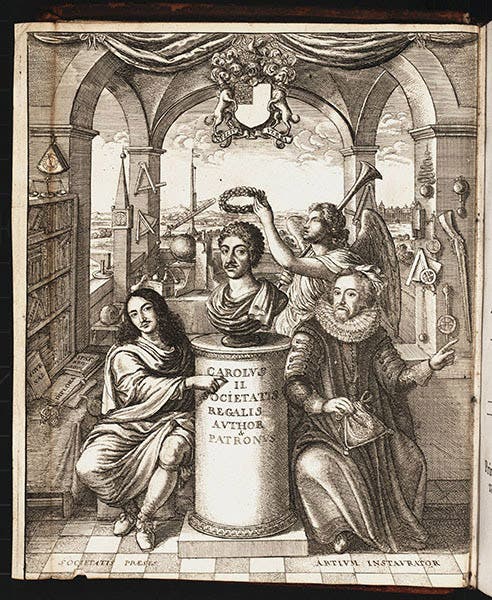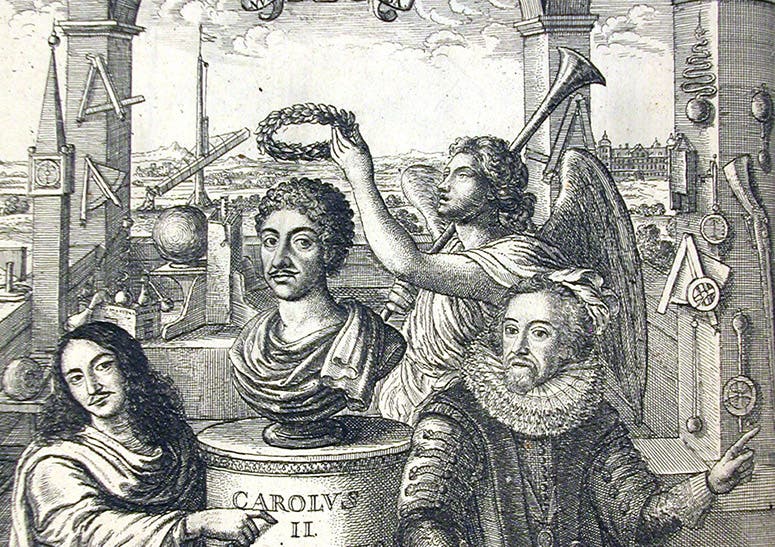Scientist of the Day - William Brouncker

Frontispiece depicting the principal supporters of the early Royal Society of London (left to right), William, Viscount Brouncker; a bust of King Charles II; and Francis Bacon; engraving by Wenceslaus Hollar after a design by John Evelyn, in Thomas Sprat, The History of the Royal-Society of London, 1667 (Linda Hall Library)
On Nov. 28, 1660, a small group of natural philosophers, a dozen or so, met at Gresham College in London, and decided to establish a society for the purpose of promoting "experimental learning." Included in that group were Robert Boyle, John Wilkins, Christopher Wren, and today's subject, William, Viscount Brouncker. The organization that began that day became the Royal Society of London, the world’s oldest continuously existing scientific society. There had been many earlier meetings involving members of this group, and others, at Oxford and in London, that may have led to this day. It is a complicated back-story, to which books have been devoted, and we will not pursue it here. But the Royal Society has always recognized Nov. 28, 1660, as its founding day.
Additional members were invited in, such as John Evelyn, but nothing much happened until July 15, 1662, when the Society secured a charter from King Charles II, and became the Royal Society. Its first President was Brouncker. Brouncker was a favorite of the King, and had stood by him during the Commonwealth of Oliver Cromwell. When Charles was restored to the throne in 1660, Brouncker was rewarded with an appointment as Chancellor to Queen Charlotte. He read papers on such subjects as gun recoil to the early meetings of the Society, but his principal contribution to the nascent group was to represent them at Charles' court, and he was no doubt instrumental in securing their charter in 1662. He was President when Robert Hooke was added to the rolls as experimental demonstrator to the Society, and when the world's first scientific journal, the Philosophical Transactions of the Royal Society, was founded in 1665, with Henry Oldenburg serving as editor of the Transactions and secretary to the Society. Brouncker was also President when Thomas Sprat was commissioned to write a history of the Royal Society, as a way of answering early critics, who dismissed the Society as a useless collection of dilettantes who pursued frivolous inquiries during their weekly meetings. Sprat took his time (he received his assignment in 1663), but his History of the Royal Society was finally completed and published in 1667, and we mention it because Brouncker was one of three people depicted in its famous frontispiece (first image). We have published a post on Sprat.
The frontispiece has a complicated history, which we related in more detail in our Sprat post and in our post on John Evelyn. Evelyn had designed it for a different book defending the Royal Society, one by his friend, John Beale, but when Sprat's book was completed, Beale gave up his own project and suggested that the frontispiece, which had already been engraved, be used for Sprat's book. It was really too large to fit, but it was folded over at bottom and sides and used anyway, at least in some of the copies (we have three copies of Sprat’s book; only one has the frontispiece). The engraving (first image) depicts a bust of Charles II, with President Brouncker on the left, pointing to Charles' name on the pedestal. On the right sits a reincarnation of Francis Bacon, Artium instaurator, “restorer of the arts,” whose advocacy for an experiment-based, inductive scientific method had been adopted by the early Society. In the background is an array of experimental apparatus, denoting what made this society different from all others (see detail, third image).
The members of the early Royal Society must have been pleased with Brouncker's efforts on their behalf at court, for he remained as President until 1677. For three of those years, 1664-67, he was also a Commissioner of the Navy, and his assistant was Samuel Pepys, which means Brouncker popped up often in Pepys' famous diary. Pepys was critical of nearly everyone, and he had his run-ins with Brouncker, but he regarded Brouncker as the best of the lot he had to deal with.
Brouncker died on Apr. 5, 1684. He was esteemed enough at court to merit a portrait that is thought to have been painted by John Lely around 1674; it hangs in the National Portrait Gallery in London (second image).
William B. Ashworth, Jr., Consultant for the History of Science, Linda Hall Library and Associate Professor emeritus, Department of History, University of Missouri-Kansas City. Comments or corrections are welcome; please direct to ashworthw@umkc.edu.








